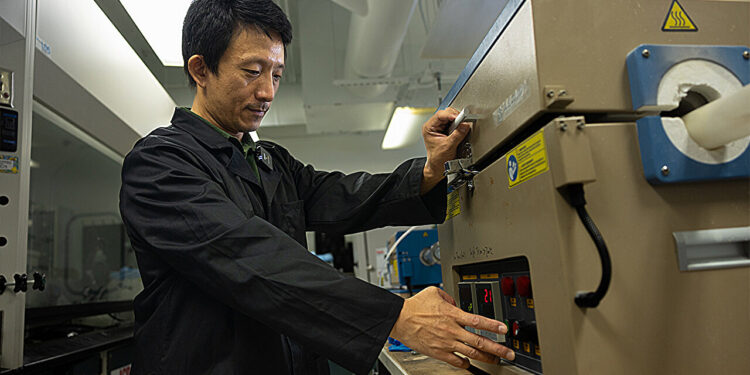Yang Yang, an associate professor in UCF’s Center for Nanoscience Technology, works with a device that helped him develop his three-phase device that captures and converts carbon dioxide. Credit: Antoine Hart
In an effort to reduce the environmental impact of carbon dioxide emissions, a University of Central Florida researcher has developed new technology that captures carbon dioxide and produces useful fuels and chemicals.
Yang Yang, an associate professor in UCF’s Center for Nanoscience Technology, has created an innovative device that captures carbon dioxide using a microsurface composed of a tin oxide film and a fluorine layer. The device then extracts the carbon dioxide gas via a bubble electrode and selectively converts the gases into carbon monoxide and formic acid, which are important raw materials for chemical manufacturing.
This technology, detailed in a recent study by Journal of the American Chemical Societyaims to sustainably reduce humanity’s carbon footprint while meeting the need to produce alternative energy.
“We want to create better technology to make our world a better and cleaner place,” said Yang, who is also a member of UCF’s Renewable Energy and Chemical Transformation (REACT) research group. “Too much carbon dioxide will have a greenhouse effect on the Earth and warm it very quickly. That’s why we want to develop this new material to take it and convert it into chemicals that we can use.”
This carbon dioxide capture technology could be implemented in power plants, industrial facilities or chemical production plants where carbon dioxide is captured from emissions and converted into useful products.
Design is born from nature
The inspiration for this device and the need to lessen our impact on the environment comes directly from nature itself, Yang explains.
“As scientists, we are always learning from nature,” he says. “We want to see how animals and trees work. For this work, we learned from the lotus. We know that the lotus has a very hydrophobic surface, which means that when you pour water on its surface, the water runs off quickly. We also know that green plants absorb carbon dioxide and convert it to oxygen through photosynthesis.”
The lotus helped Yang design a carbon dioxide capture technology that mimics the lotus surface, in which water flowing over a device’s manufactured hydrophobic surface would be separated from the carbon dioxide conversion reaction.
It is necessary to carefully manage the amount of water on the surface of the materials that could flood the device or disrupt the conversion of carbon dioxide, Yang explains.
Once captured, the carbon dioxide is then routed through an electrode and converted through a process that is more customizable than natural photosynthesis.
The electrocatalytic reduction reaction of carbon dioxide converts carbon dioxide into carbon-containing chemicals, such as methanol, methane, ethylene, ethanol, acetate, and propanol, depending on specific reaction pathways on the catalysts.
“We want to create a better material that can quickly capture carbon dioxide molecules from the air and convert them into chemicals,” Yang says. “We simply reduce the concentration of carbon dioxide in the air and convert it into liquid and gas phases so that we can directly use these converted chemicals and fields for other applications.”
One of the most challenging aspects of the research was reducing the amount of water spilled onto the surface of the catalytic materials when exposing the carbon dioxide gas components in the liquid electrolyte, he said.
“If your materials are surrounded by too much water, you risk producing hydrogen instead of converting carbon dioxide into chemicals,” Yang says. “This will reduce the energy efficiency of the entire process. The materials we use can repel water from the surface, which allows us to avoid the formation of hydrogen and greatly improve the efficiency of carbon dioxide reduction. So this means that eventually we will be able to use almost all the electricity for our reaction.”
Scaling Up
There are many efforts underway around the world to reduce, capture or convert carbon dioxide, including planting trees and developing large-scale carbon capture technologies. Yang hopes that the carbon capture and conversion device can serve as a viable alternative to other more time-consuming or expensive methods.
According to Yang, harnessing environmentally friendly electricity is another step in implementing carbon dioxide conversion technology.
“In our process, we can use intermittent electricity, such as electricity from the solar panel or wind farm,” he says.
This technology builds on Yang’s previous energy efforts at UCF nearly three years ago, developing new materials for fuel cells using fluorine-enhanced carbon.
This research is an important first step and constitutes a fundamental study that could pave the way for methods of capturing carbon dioxide on a larger scale, Yang says.
“For this, we validated our concept from a fundamental point of view,” he explains. “We tested the performance of our reactors, but in the future we want to develop a larger prototype that can show people how quickly we can convert and reduce the concentration of carbon dioxide and generate chemicals or fuels very quickly from our large-scale prototype.”
Researchers, students, and postdoctoral fellows from the UCF Department of Materials Science and Engineering, NanoScience Technology Center, and Department of Chemistry include Lei Zhai; Fnu Joshua, MS; David Fox, PhD; Shengwen Liu; Zhao Li, PhD; Jinfa Chang; Guanzhi Wang, PhD; Ao Yu; and Wei Zhang, PhD.
Yang has also collaborated with the University of Houston, the University of California at Berkeley, Stanford University and the Oriental Institute for Advanced Study in Ningbo, China.
More information:
Wei Zhang et al., Balanced and proactive CO dynamic bubbles2 Capture and reduction on a nanoporous electrocatalyst with three-phase interface, Journal of the American Chemical Society (2024). DOI: 10.1021/jacs.4c02786
Provided by the University of Central Florida
Quote:New device captures CO₂ and converts it into useful products (2024, August 20) retrieved August 20, 2024 from
This document is subject to copyright. Apart from any fair dealing for the purpose of private study or research, no part may be reproduced without written permission. The content is provided for informational purposes only.



